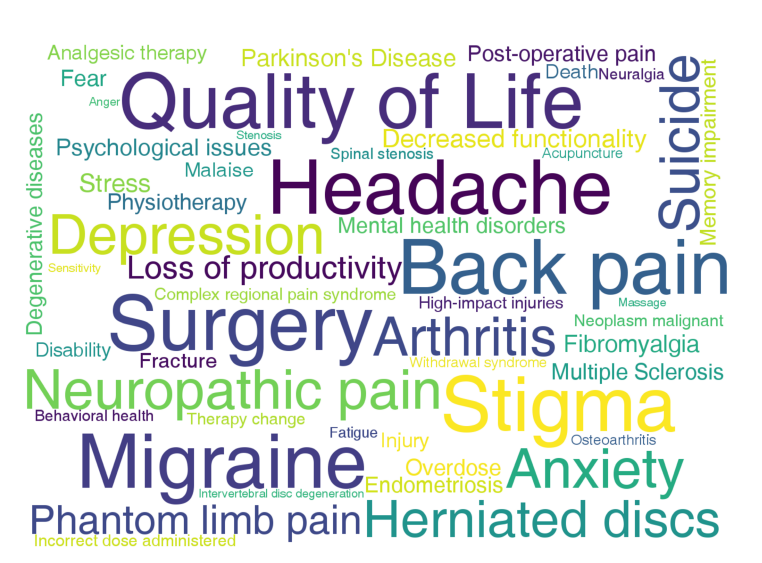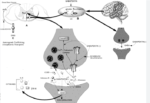Pain is a signal in your nervous system that something may be wrong. It is an unpleasant feeling, such as a prick, tingle, sting, burn, or ache.

Pain may be sharp or dull. It may come and go, or it may be constant. You may feel pain in one area of your body, such as your back, abdomen, chest, pelvis, or you may feel pain all over.
Pain can be helpful in diagnosing a problem. If you never felt pain, you might seriously hurt yourself without knowing it, or you might not realize you have a medical problem that needs treatment.
There are two types of pain: acute and chronic. Acute pain usually comes on suddenly, because of a disease, injury, or inflammation. It can often be diagnosed and treated. It usually goes away, though sometimes it can turn into chronic pain. Chronic pain lasts for a long time, and can cause severe problems.
Pain is not always curable, but there are many ways to treat it. Treatment depends on the cause and type of pain. There are drug treatments, including pain relievers. There are also non-drug treatments, such as acupuncture, physical therapy, and sometimes surgery.
Three are so many kinds of pains in the body including acute pain and chronic pain.
Pain is one of the most common reasons Americans consult a physician. There are two types of pain: acute and chronic. Acute pain is caused by a specific condition like a broken bone or childbirth, and typically goes away once the underlying cause ends or is fixed. Chronic pain is ongoing pain that usually lasts longer than six months. It can stem from an injury, infection, or disease such as arthritis or cancer. Sometimes chronic pain has no known cause. Environmental and psychological factors can often make chronic pain worse.
According to a 2018 report by the Centers for Disease Control and Prevention (CDC), 50 million U.S. adults have chronic pain. Approximately 19.6 million American adults have high-impact chronic pain that limits at least one major life activity. One-third of people with high-impact chronic pain have difficulty with self-care activities like getting dressed.
Chronic pain is more prevalent and of greater intensity in the Veteran population than in the general population. It is often accompanied by co-existing mental health conditions. Unrelieved and persistent chronic pain can contribute to depression, anxiety, poor sleep patterns, decreased quality of life, and substance use disorder. It is also a risk factor for suicide. The consequences of chronic pain include lost work productivity, disability, and increased health care costs.
Joint and back pain and other musculoskeletal ailments are the most common diagnoses among Iraq and Afghanistan Veterans. In a 2017 report by the National Institutes of Health (NIH), 65.6% of American Veterans reported having pain in the three months before they were surveyed, with 9.1% classified as having severe pain. Severe pain was 40% greater in Veterans than non-Veterans, especially among those who served in recent conflicts.
In General, Pain can be classifieds as:
MUSCULOSKELETAL PAIN
- Back and Leg Pain
- Neck, Shoulder and Arm Pain
- “Whiplash” Injuries
- Motor Vehicle, Work-Related and Sports Injuries
- Failed Back Surgery and Other Post Surgical Pain Syndromes
- Pain Due to Arthritis
- Fibromyalgia
- Primary and Metastatic Cancer Pain
- Medication Side Effect Management
PAIN ASSOCIATED WITH OTHER CONDITIONS
- Vascular Pain
- Raynaud’s Disease
- Psychogenic Pain
- Trigeminal Neuralgia
- Spinal Cord Injury
- Spasticity
- Pelvic Pain
- Pediatric Pain
- Complex Regional Pain Syndrome(RSD)
- Shingles
- Neuralgia
- Nerve Injuries
- Phantom Limb Pain
Also, Pain can be classified as:
- Depression
- Fibromyalgia Facts
- Menstrual Cramps
- Tylenol Liver Damage
- Chronic Pain
- Headache
- Cancer Pain
- Anxiety
- Pain Management
- Fatigue
- Antidepressants
- NSAIDs (Nonsteroidal Antiinflammatory Drugs)
- Anxiety Medications
- Rheumatoid Arthritis (RA) Medications
Pain Medications, Pain Relief, and Pain Management





